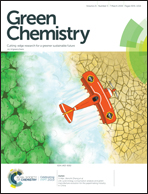Calcium hypophosphite mediated deiodination in water: mechanistic insights and applications in large scale syntheses of d-quinovose and d-rhamnose†‡
Abstract
The inorganic calcium hypophosphite was found to be a cheap, non-toxic, water-soluble and environmentally friendly reducing reagent for radical deiodination in water. Thorough mechanism studies revealed that calcium hypophosphite was oxidized to water insoluble calcium phosphite which was the major co-product of the deiodination reaction. Based on this observation, a practical synthesis of rare D-quinovose and D-rhamnose from cheap and commercially available materials on a hundred-mmol scale was reported.



 Please wait while we load your content...
Please wait while we load your content...